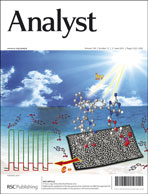The orientation of sensing molecules on solid phase biosensors has to be optimized to facilitate efficient binding of analytes. Since conventional observation methods (e.g., electron microscopy, atomic force microscopy, time-of-flight secondary ion mass spectrometry) require exaggerated machines and possess insufficient resolution for single molecule analyses, functional assays based on the reactivity to analytes have thus far been used for this optimization. However, it is not clear whether these assays can judge whether sensing molecules are fixed in an oriented-immobilization manner or not. Here, we describe that bio-nanocapsules of about 30 nm diameter, displaying approximately 120 molecules of a tandem form of the immunoglobulin (Ig) G Fc-binding Z domain (ZZ-BNCs), can discriminate between the Fc regions of IgGs fixed in an oriented-immobilization manner and those fixed randomly, thus facilitating the evaluation of the orientation of IgGs in immunosensors. Furthermore, in sandwich immunoassays, ZZ-BNCs can bind specifically to detection-IgGs fixed in an oriented-immobilization manner by antigen-capture IgG complexes, rather than to capture-IgGs fixed randomly onto a solid phase, allowing the simultaneous use of the same IgG as capture- and detection-IgGs. Thus, we demonstrate that ZZ-BNCs are a unique probe for evaluating the orientation of IgGs on a solid phase.

You have access to this article
 Please wait while we load your content...
Something went wrong. Try again?
Please wait while we load your content...
Something went wrong. Try again?


 Please wait while we load your content...
Please wait while we load your content...